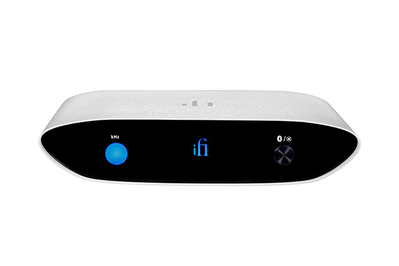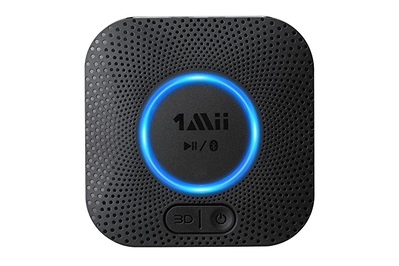The 6 Best Bluetooth Audio Receivers and Transmitters of 2025
If you want to stream audio from your phone or computer to an older, non-Bluetooth–friendly home-audio system, you want a more robust Bluetooth audio receiver that can sit in your equipment rack and connect directly to your gear — be it an amp-and-speaker combo, a pair of powered speakers, or maybe an older soundbar. These Bluetooth receivers are usually larger than portable headphone adapters and are not battery-powered.
Sound quality is probably your number one priority here, and these receivers support higher-quality Bluetooth codecs. Indoor signal range, as well as the ability to receive a signal through multiple walls or in the presence of other radio-frequency devices like Wi-Fi routers and smart-home appliances, is also important.
Top pick: iFi Audio Zen Air Blue

Top pick
The iFi Audio Zen Air Blue offers Bluetooth 5.0 connectivity and supports all relevant Bluetooth audio codecs, including SBC, AAC, aptX, aptX Adaptive, aptX HD, aptX LL, LDAC, and LHDC/HWA. It also offers great signal range, and it’s the simplest and most straightforward receiver we tested in respect to setup and daily use.
The receiver sounds great. In our listening tests, its sound quality was practically indistinguishable from that of its much more expensive sibling, the now-discontinued Zen Blue V2. It uses the same ESS Sabre ES9023 Premier Stereo digital-to-analog converter, which is a great-sounding DAC.
In our audio comparisons, we couldn’t hear a meaningful difference between the DAC in this little $100 box and the DAC in the $1,100 Rotel A12 MKII integrated amplifier that we used for testing.
The Bluetooth performance is reliable. Pairing the Zen Air Blue proved to be as easy as with most of the other Bluetooth receivers we tested, and its reconnection with sources was far above average in reliability, consistency, and speed.
In our range tests, the Zen Air Blue held its connection perfectly up to a distance of about 32 feet in a direct line indoors. But more importantly, the signal passed through five sheetrocked walls before the audio started to stutter, skip, or take too long to reconnect. In practice, that meant that we could walk to any corner of any room in the house with the phone in our hand or pocket without losing a signal.
It’s more user-friendly than other receivers in its price class. First, it’s always on, so all you have to do is connect to it and switch to the appropriate input on your sound system, and you’re ready to listen without delay.
It also gives a nice verbal confirmation when a device is connected, and it lets you know which codec is being employed so you can be sure the device is receiving the best codec possible — for instance, “Device is connected … AAC.”
If you happen to miss that vocal announcement, the unit also gives visual feedback about the quality of the incoming signal by way of two front-panel LED lights. One light indicates the Bluetooth codec, and the other indicates signal resolution.
From the very first note, the Zen Air Blue never failed to deliver sound. Many receivers, especially in this price range, mute the audio when no music is playing and often take a second or two to unmute when sensing a signal, but this iFi model never did so. It also handled gapless albums like some of our Grateful Dead concert albums, as well as studio albums like the Black Crowes’ The Southern Harmony and Musical Companion, without any pauses or silences between tracks.
Connection options are limited. The only audio output is an analog RCA stereo pair. There are no digital audio outputs, which may be a concern for you if the only available audio connection on your home stereo or speakers is optical or coaxial digital — or if you would prefer to use the DAC built into your audio gear (or an external DAC, for that matter).
We formerly recommended the Zen Blue V2 as an upgrade pick if you needed digital outputs or even better Bluetooth signal range. However, that model has been discontinued and replaced by the Zen Blue 3, a transmitter/receiver combo that supports Bluetooth 5.4 and aptX Lossless and adds analog and digital inputs (including USB-C). But it comes with a big price jump to $300, so it’s likely overkill for most people looking solely for a Bluetooth audio receiver.
A few key accessories are missing. The Zen Air Blue doesn’t come with audio cables of any sort, so you need to purchase a good pair of stereo RCA interconnects.
More frustrating is the fact that the receiver doesn’t come with a USB power adapter. Its 5-volt DC power cord terminates in a USB Type-A connection, which you can plug into the USB power port on the back of most audio components these days, but if your sound system is older or for whatever reason omits such a connection, you need to buy a good USB wall charger.
The always-on nature of the Zen Air Blue can be a blessing and a curse. It means that you won’t have to remember to turn it on before use, but it also means that your portable devices might sometimes connect to the Bluetooth receiver when you don’t want them to.
If your sound system has a USB power outlet, you might benefit from plugging the Zen Air Blue into that outlet instead of the wall so it powers up and down with the rest of your audio gear. Just be aware that some sound systems send pass-through power to their USB ports even in standby mode.
Budget pick: 1Mii B06 Plus

Budget pick
If you want to keep your spending to a minimum, the 1Mii B06 Plus is a surprisingly good Bluetooth audio receiver for under $30. It uses Bluetooth 5.3, supports higher-quality codecs such as aptX HD and aptX Low Latency, and had one of the best signal-range results in our tests. It’s also simple to configure and not as susceptible to noise as some other Bluetooth receivers we tested.
The B06 Plus sounds great for the price. In our listening tests, this receiver’s sound quality was somewhat dependent upon the transmitting device. iOS users are likely to lament its lack of support for the AAC codec, but standard SBC sounded as good as what we heard from the Bluetooth built into the NAD C 3050 integrated amplifier. Switching over to an Android tablet, we found that using the aptX HD codec produced some minor improvements in sound quality, mostly with regard to higher frequencies; the improvements were easier to appreciate over headphones.
The B06 Plus doesn’t have digital outputs, offering only stereo RCA and 3.5 mm analog outputs. And its built-in DAC isn’t quite up to par with that of the iFi Audio Zen Air Blue. But considering the price gap between the two models, the differences aren’t nearly as pronounced as you might expect.
The Bluetooth connection is pretty reliable. Pairing the B06 Plus was simple and painless, and in my range tests it held its own against some notably pricier competitors. The signal passed through five sheetrock walls just fine and only occasionally suffered minor dropouts, mostly when I was running the microwave. Only the iFi Audio Bluetooth receivers I tested provided substantially more range.
It comes with most of the accessories you need. Unlike many affordable Bluetooth receivers we tested, the B06 Plus comes with a USB wall charger, so you don’t need to power it with a spare USB cable or port.
If your gear does have a powered USB port, note that in our tests the B06 Plus didn’t suffer from the sort of interference we experienced with some pricier alternatives. This receiver sounded clean and noise-free no matter how we powered it, even via a noisy USB port on the front of our desktop PC.
Our one gripe regarding the supplied accessories is that, instead of stereo RCA cables, the package includes a 3.5 mm–to–RCA adapter cable. This is a fine-sounding option, but the 3.5 mm aux output is plastic and feels a bit fragile; we got a more secure connection using a pair of Monoprice RCA cables.
This receiver has an off button. At times, I left the B06 Plus powered on for weeks, which was nice because it meant I didn’t have to remember to turn it on before use. But sometimes my iPhone connected to the receiver and started playing audio when I didn’t want it to, which made me appreciate the inclusion of an easy-to-reach power button to switch the receiver off.
That said, the power button sits beside the 3D button (more on that in a sec), replacing the volume controls that you get on other 1Mii receivers that have this same form factor. But I preferred using the volume controls on my phone or stereo system anyhow.
The 3D-audio feature is a mostly pointless gimmick. If you’re thinking of buying the B06 Plus purely for its advertised “3D Surround” feature, don’t bother. Not that the feature’s presence should deter you, but the surround effect is really dependent on the content being played. It’s subtle at best, and when it is audible, it mostly just sounds like a slight echo or reverb effect.








